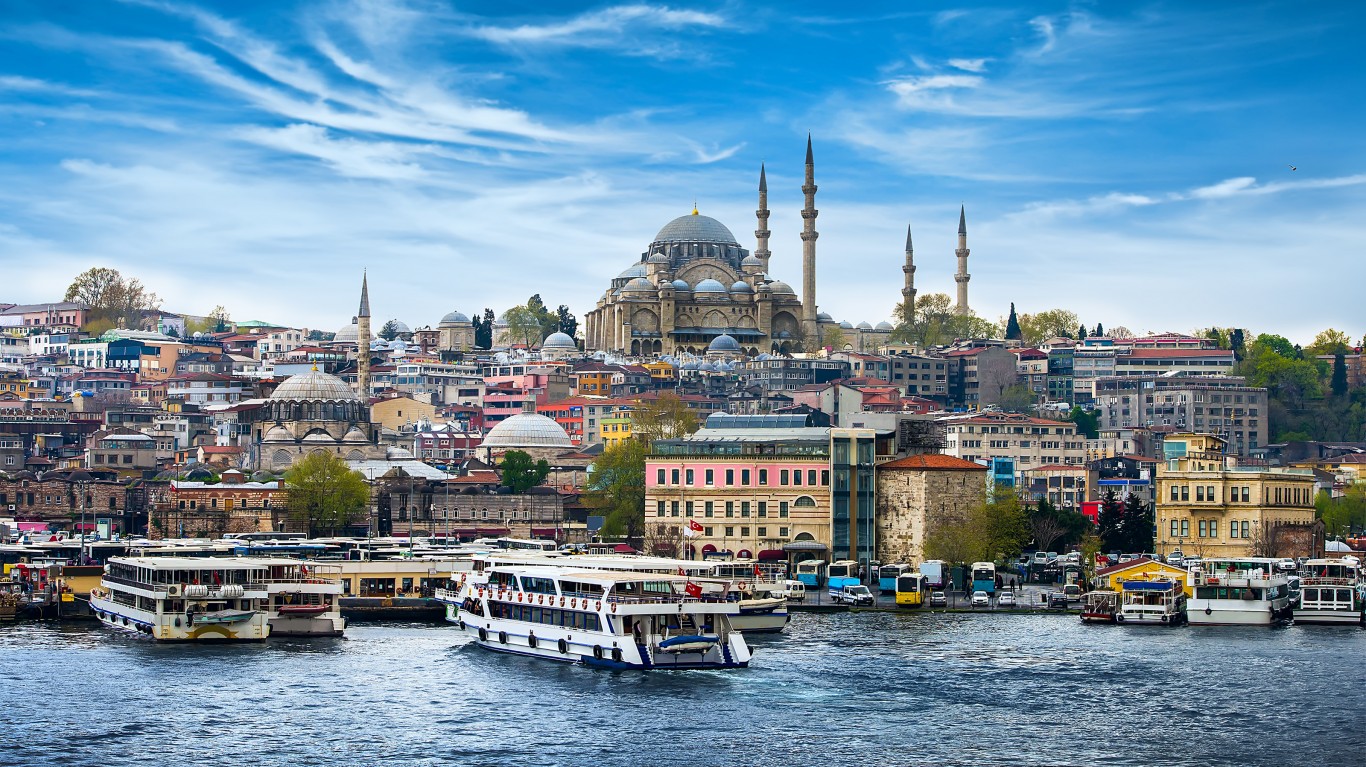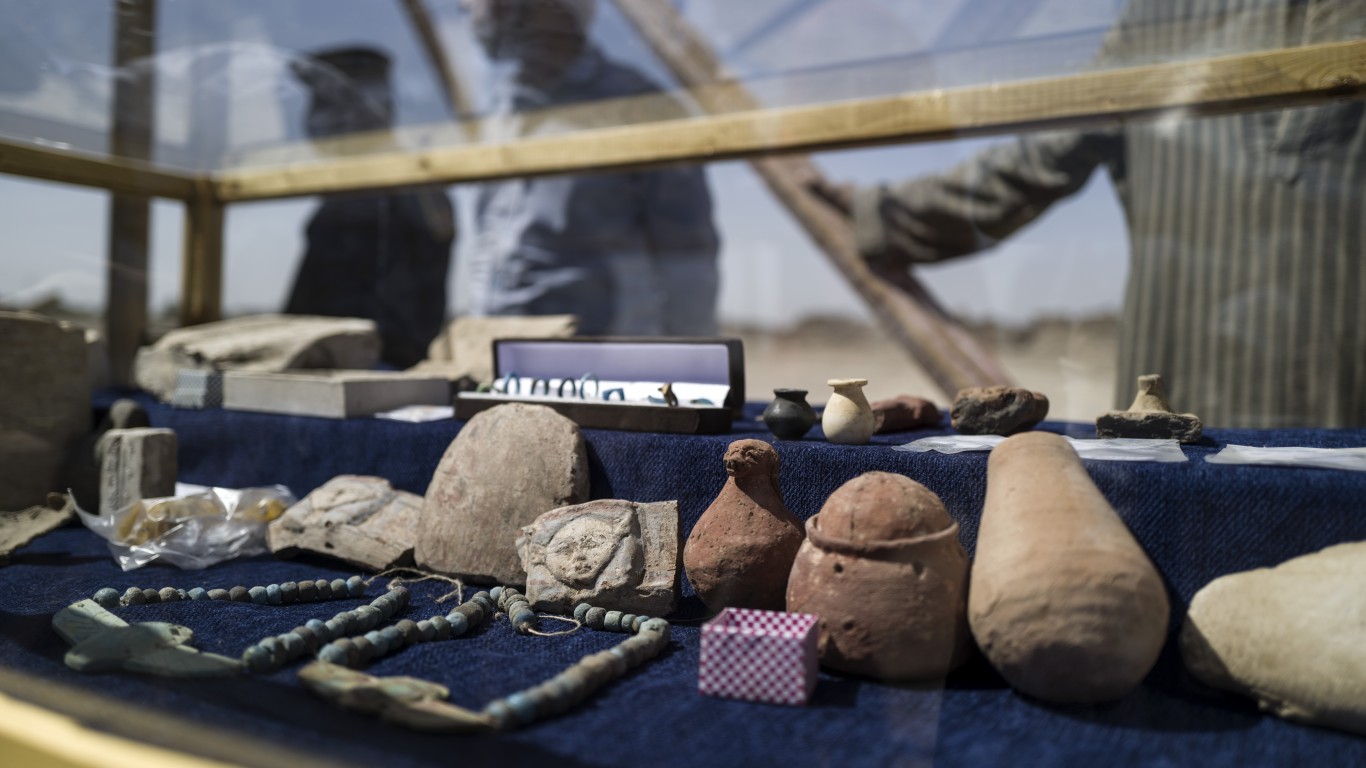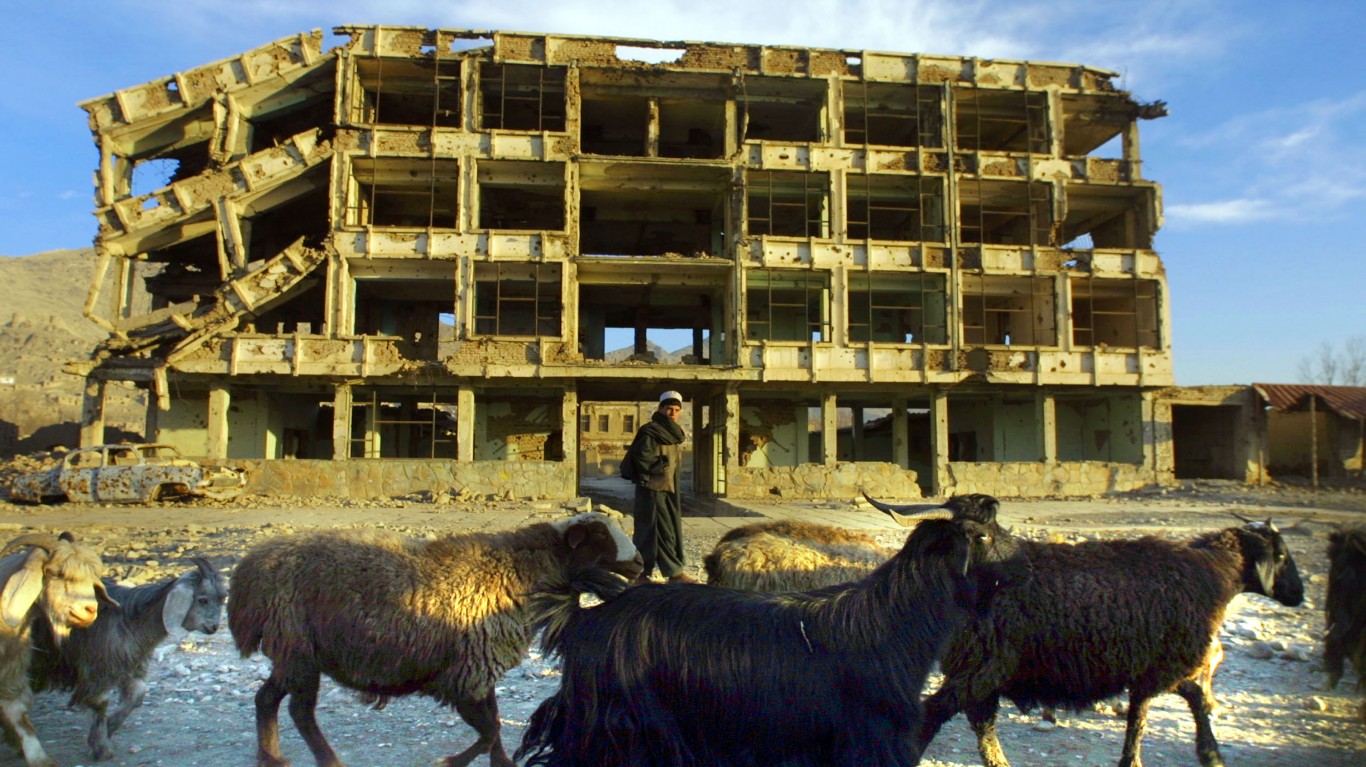
Capturing a capital city or a nation’s largest urban center is the ultimate trophy attained in war. Some cities have had to suffer that indignity more than once. (Here are 26 cities that have been destroyed by war in the last 200 years.)
To compile a list of major cities around the world that have been frequently invaded, 24/7 Tempo consulted numerous historical and general interest websites, including History, Britannica, Smithsonian, ThoughtCo, National Geographic, and Library Ireland. The list of each city’s invaders is representative, recording some of the most significant invasions, but is not complete. For instance, it is estimated that Jerusalem has been invaded 44 times throughout its history, and the Sicilian city of Palermo proudly calls itself “the most conquered city in the world.”
Armies aspire to conquer major cities for many reasons.
A major city can have strategic importance, such as Constantinople, located at the narrowest point of the Bosphorus Strait, or Singapore, at the southern tip of the Malay Peninsula. Another example is Palermo, Sicily, in the middle of the Mediterranean Sea.
Other cities can hold a religious significance, like Jerusalem – important to Judaism, Christianity, and Islam – which has been fought over for more than 3,000 years. Baghdad, a key city along trading routes, is another urban center that has been vanquished many times in its history. Tenochtitlán, which evolved into Mexico City, succumbed to Hernán Cortés and the Spanish conquistadors seeking gold in the Western Hemisphere. (These were the mega-cities of the ancient world.)
Click here to learn about 15 major cities that have been captured often by invaders
Cities such as Rome, Paris, and London are steeped in history and carry a mystique that has little or nothing to do with their strategic or religious significance. While both Rome and Paris were occupied by the Germans during World War II, London has remained untouched by foreign incursions since William the Conqueror succeeded in 1066.

Jerusalem, present-day Israel
> Invaders: King David (circa 1000 B.C.?), Egyptians (926 B.C.), Babylonians (597 B.C.), Greeks (332 B.C.), Romans (37 B.C.), Byzantine Empire (313), Arabs (636), First Crusade (1099), Mamluks (1260), Ottoman Empire (1516), British (1917)
Given its age and importance to three of the world’s religions, it is not surprising that Jerusalem has been the object of conquest for at least three millennia. The last time it was conquered was during World War I when the British wrested the city from the decaying Ottoman Empire. That led to the creation of the British Mandate that lasted until 1948 and the founding of the nation of Israel. The Mandate divided the city between Israel and Jordan, and Israel reunited it in 1967 following the Six-Day War.
[in-text-ad]

Damascus, present-day Syria
> Invaders: Neo-Assyrian Empire (732 B.C.), Neo-Babylonian Empire (572 B.C.), Alexander the Great (333 B.C.), Romans (150), Arabs (634), Ottoman Empire (1516), Arabs and British forces (1918), French (1920)
Damascus, one of the oldest cities in the world, was last conquered by the French in 1920 during the Franco-Syrian War. The secret Sykes-Picot Agreement in 1916 partitioned the Ottoman Empire into spheres of influence for France and Great Britain, and France received the area that includes present-day Syria. Before the Franco-Syrian War, Arab forces and the British seized the city from the Ottoman and German empires during World War I, ending almost 400 years of Ottoman rule.

Constantinople/Istanbul, present-day Turkey
> Invaders: Achaemenid (Persian) Empire (510 B.C.), Romans (70 B.C.), Byzantine Empire (324), Ottoman Empire (1453)
The conquest of the strategically important city of Constantinople, astride the continents of Europe and Asia, by the Ottoman Empire in 1453 was among the most consequential events in Europe in the past 600 years. It marked the official end of the Byzantine Empire and positioned the Ottoman Empire to expand into Eastern Europe and the Balkans.

Athens, Greece
> Invaders: Achaemenid (Persian) Empire (480, 479 B.C.), Sparta (406 B.C.), Romans (146 B.C.), Herulians (267), Visigoths (395), Ottoman Empire (1458), Germans and Italians (1941)
Athens, the cradle of democracy, which produced philosophers such as Diogenes, Plato, and Socrates, succumbed to many invasions in the ancient era. In more recent times, the city fell to the fascist forces of Germany and Italy in 1941, with the Axis troops destroying many of its priceless temples and its statuary from antiquity.
[in-text-ad-2]

Palermo (Sicily), present-day Italy
> Invaders: Romans (254 B.C.), Vandals (445), Ostrogoths (491), Byzantine Empire (535), Arabs (831), Normans (1072), Holy Roman Empire (1194), Aragonese (1282), Italians (1860), Western Allies (1943)
A look at the map of the Mediterranean Sea helps explain why Palermo has been the target of conquest for hundreds of years. Sicily is at the crossroads of the Mediterranean and holds significant strategic value. The most recent conquerors of Sicily’s capital were troops from the U.S. 7th Army under the command of General George Patton in 1943.

Lutetia/Paris, present-day France
> Invaders: Romans (52 B.C.), Vikings (845), Germans (1940)
Lutetia, the predecessor city of where Paris is today, was a small village at the time the Romans conquered it in the first century. Succeeding invasions were carried out by Vikings during the ninth century. The most recent conquest was by Nazi Germany when France collapsed from the German invasion in 1940. The city would be liberated by the Western Allies four years later.
[in-text-ad]

Rome, present-day Italy
> Invaders: Visigoths (410), Vandals (455), Ostrogoths (537-538), Normans (1084), Holy Roman Empire (1527), French (1789), Western Allies (1944).
Rome has been taken over seven times in its storied history. The first conquest, by the Visigoths in 410, shattered Roman invincibility forever. As defeats piled up for the Italian Army in World War II, Rome was declared an open city, meaning it could be captured without street fighting. The Western Allies liberated Rome in 1944.
Aleppo, present-day Syria
> Invaders: Sasanian Persians (540), Saladin (1183), Mongols (1260), Ottoman Empire (1516), Western Allies (1918), French (1920), Syrian rebels/ISIS (2012)
ISIS, the fanatical Islamic group that captured wide swaths of Iraq and Syria about a decade ago, seized Aleppo in 2012. They were not the first to do so. Western Allies took the city from the Ottoman Empire in 1918 in the last days of World War I and the French captured it during the Franco-Syrian War two years later.

Dublin, Ireland
> Invaders: Danes (836), Irish of Leinster and Meath (845), Danes and Norwegians (853), Anglo-Normans (1170)
Ireland was the target of Viking raids in the eighth and ninth centuries and these led to the creation of Dublin. The Danes and others sacked Dublin during this time, and the emerging Irish city eventually fell to the Anglo-Normans in the 12th century. In time it would be absorbed into the holdings of the English crown, where it would be held until the creation of the Republic of Ireland in 1949.
[in-text-ad-2]

London, England
> Invaders: Vikings (842, 851), Danes (871), West Saxons (886), Danes (1013), Normans (1066)
There have been several famous attempts to invade England and conquer London – the Spanish Armada in 1588, Napoleon in 1805, and Nazi Germany in 1940 – but all failed. The last to accomplish this was the Norman monarch William the Conqueror in 1066. Invasions by vikings, Danes, and West Saxons predated William’s conquest.

Baghdad, present-day Iraq
> Invaders: Seljuks (1136, 1157), Mongols (1258), Ottoman Empire (1534, 1638), Saffavid Persians (1624), British (1917), Americans (2003)
Baghdad, most recently occupied by the United States and its Allies during the Iraq War, has suffered various invasions. None was worse than the sacking of the city by the Mongols in 1258. The Mongol conquest ended the so-called Islamic golden age as the invaders razed the city, then home to more than a million people.
[in-text-ad]

Kyiv, present-day Ukraine
> Invaders: Grand Duchy of Vladimir-Suzdal (1169), Mongols (1240), Lithuanians (1362), Bolshevik Red Guards (1918), Germans (1918), Soviets (1920), Germans (1941)
In February, Russia had hoped to make quick work of the Ukrainian opposition and become the latest in a long line of conquerors of Kyiv. The city is the center of the first Slavic state, Kyivan Rus, and as such is considered the birthplace of both Ukraine and Russia. The Russians failed to accomplish their goal earlier this year, and the war has dragged on. When Nazi Germany overran Ukraine and captured Kyiv in September 1941, the German Army encircled five separate Soviet armies and killed or captured about 700,000.

Moscow, present-day Russia
> Invaders: Mongols (1237), Crimean Tatars (1571), Swedes (1610), Poles and Lithuanians (1611), French (1812)
Moscow was established in the 12th century and not long after its founding, it was conquered by the Mongols. The Crimean Tatars would accomplish the same feat 300 years later, followed by the Swedes, Poles, and Lithuanians in the 17th century. Napoleon succeeded in occupying Moscow in 1812 with his Grande Armée, but the Muscovites left him little to conquer, employing a scorched-earth policy that razed Moscow. About 130 years later, the Nazis raced against the calendar to try to take the Russian capital before winter, but failed to do so. They were thwarted by the bitter Russian cold and Adolf Hitler’s repeated changes in invasion priorities.

Tenochtitlán/Mexico City, present-day Mexico
> Invaders: Spanish (1521), Americans (1848), French (1863)
Spanish conquistadors and local tribes led by Hernán Cortés conquered the Aztec capital city of Tenochtitlán. Cortés’s army laid siege to Tenochtitlán for 93 days and prevailed because of better weapons and a smallpox outbreak that ravaged the Aztecs. American forces famously routed the Mexican Army in the Mexican-American War and conquered Mexico City in 1848. Thirteen years later, France invaded Mexico under the pretext that Mexico was not paying France a foreign debt, eventually seizing Mexico City in 1863.
[in-text-ad-2]

Singapore
> Invaders: Portuguese (1613), British (1819), Japanese (1942)
Before it became one of the Asian economic tigers, Singapore was occupied by the Portuguese, and then became a crown colony of the British Empire. During the war in the Pacific in World War II, the British fortified the city with a naval base, leading Winston Churchill to call it “the Gibraltar of the East.” The Japanese conquered the city by invading from the north through what the British thought was an impregnable jungle. They captured 130,000 Indian, Australian, and British troops, the largest surrender of British-led forces in history.
Take Charge of Your Retirement In Just A Few Minutes (Sponsor)
Retirement planning doesn’t have to feel overwhelming. The key is finding expert guidance—and SmartAsset’s simple quiz makes it easier than ever for you to connect with a vetted financial advisor.
Here’s how it works:
- Answer a Few Simple Questions. Tell us a bit about your goals and preferences—it only takes a few minutes!
- Get Matched with Vetted Advisors Our smart tool matches you with up to three pre-screened, vetted advisors who serve your area and are held to a fiduciary standard to act in your best interests. Click here to begin
- Choose Your Fit Review their profiles, schedule an introductory call (or meet in person), and select the advisor who feel is right for you.
Why wait? Start building the retirement you’ve always dreamed of. Click here to get started today!
Thank you for reading! Have some feedback for us?
Contact the 24/7 Wall St. editorial team.
 24/7 Wall St.
24/7 Wall St. 24/7 Wall St.
24/7 Wall St.
 24/7 Wall St.
24/7 Wall St.
